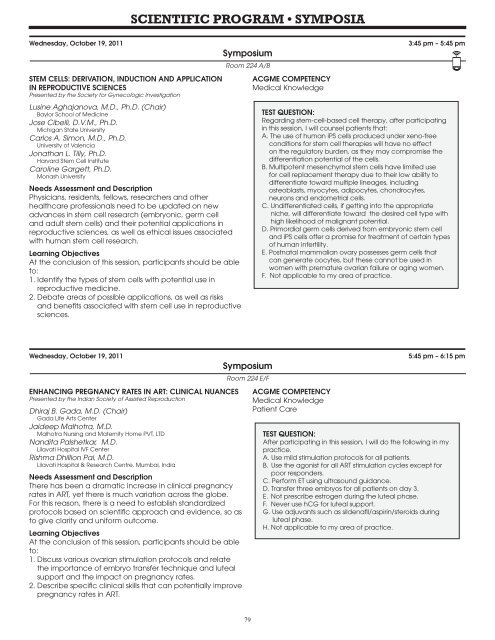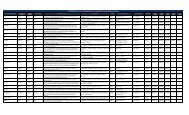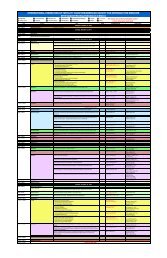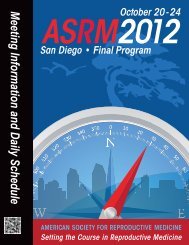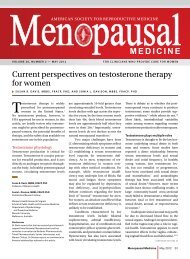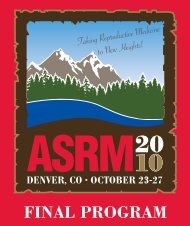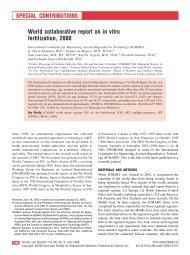scientific program • symposia - American Society for Reproductive ...
scientific program • symposia - American Society for Reproductive ...
scientific program • symposia - American Society for Reproductive ...
You also want an ePaper? Increase the reach of your titles
YUMPU automatically turns print PDFs into web optimized ePapers that Google loves.
STEM CELLS: DERIVATION, INDUCTION AND APPLICATION<br />
IN REPRODUCTIVE SCIENCES<br />
Presented by the <strong>Society</strong> <strong>for</strong> Gynecologic Investigation<br />
Lusine Aghajanova, M.D., Ph.D. (Chair)<br />
Baylor School of Medicine<br />
Jose Cibelli, D.V.M., Ph.D.<br />
Michigan State University<br />
Carlos A. Simon, M.D., Ph.D.<br />
University of Valencia<br />
Jonathan L. Tilly, Ph.D.<br />
Harvard Stem Cell Institute<br />
Caroline Gargett, Ph.D.<br />
Monash University<br />
SCIENTIFIC PROGRAM <strong>•</strong> SYMPOSIA<br />
Wednesday, October 19, 2011 3:45 pm – 5:45 pm<br />
Symposium<br />
Room 224 A/B<br />
Needs Assessment and Description<br />
Physicians, residents, fellows, researchers and other<br />
healthcare professionals need to be updated on new<br />
advances in stem cell research (embryonic, germ cell<br />
and adult stem cells) and their potential applications in<br />
reproductive sciences, as well as ethical issues associated<br />
with human stem cell research.<br />
Learning Objectives<br />
At the conclusion of this session, participants should be able<br />
to:<br />
1. Identify the types of stem cells with potential use in<br />
reproductive medicine.<br />
2. Debate areas of possible applications, as well as risks<br />
and benefits associated with stem cell use in reproductive<br />
sciences.<br />
ENHANCING PREGNANCY RATES IN ART: CLINICAL NUANCES<br />
Presented by the Indian <strong>Society</strong> of Assisted Reproduction<br />
Dhiraj B. Gada, M.D. (Chair)<br />
Gada Life Arts Center<br />
Jaideep Malhotra, M.D.<br />
Malhotra Nursing and Maternity Home PVT, LTD<br />
Nandita Palshetkar, M.D.<br />
Lilavati Hospital IVF Center<br />
Rishma Dhillion Pai, M.D.<br />
Lilavati Hospital & Research Centre, Mumbai, India<br />
Needs Assessment and Description<br />
There has been a dramatic increase in clinical pregnancy<br />
rates in ART, yet there is much variation across the globe.<br />
For this reason, there is a need to establish standardized<br />
protocols based on <strong>scientific</strong> approach and evidence, so as<br />
to give clarity and uni<strong>for</strong>m outcome.<br />
Learning Objectives<br />
At the conclusion of this session, participants should be able<br />
to:<br />
1. Discuss various ovarian stimulation protocols and relate<br />
the importance of embryo transfer technique and luteal<br />
support and the impact on pregnancy rates.<br />
2. Describe specific clinical skills that can potentially improve<br />
pregnancy rates in ART.<br />
79<br />
ACGME COMPETENCY<br />
Medical Knowledge<br />
TEST QUESTION:<br />
Regarding stem-cell-based cell therapy, after participating<br />
in this session, I will counsel patients that:<br />
A. The use of human iPS cells produced under xeno-free<br />
conditions <strong>for</strong> stem cell therapies will have no effect<br />
on the regulatory burden, as they may compromise the<br />
differentiation potential of the cells.<br />
B. Multipotent mesenchymal stem cells have limited use<br />
<strong>for</strong> cell replacement therapy due to their low ability to<br />
differentiate toward multiple lineages, including<br />
osteoblasts, myocytes, adipocytes, chondrocytes,<br />
neurons and endometrial cells.<br />
C. Undifferentiated cells, if getting into the appropriate<br />
niche, will differentiate toward the desired cell type with<br />
high likelihood of malignant potential.<br />
D. Primordial germ cells derived from embryonic stem cell<br />
and iPS cells offer a promise <strong>for</strong> treatment of certain types<br />
of human infertility.<br />
E. Postnatal mammalian ovary possesses germ cells that<br />
can generate oocytes, but these cannot be used in<br />
women with premature ovarian failure or aging women.<br />
F. Not applicable to my area of practice.<br />
Wednesday, October 19, 2011 5:45 pm – 6:15 pm<br />
Symposium<br />
Room 224 E/F<br />
ACGME COMPETENCY<br />
Medical Knowledge<br />
Patient Care<br />
TEST QUESTION:<br />
After participating in this session, I will do the following in my<br />
practice.<br />
A. Use mild stimulation protocols <strong>for</strong> all patients.<br />
B. Use the agonist <strong>for</strong> all ART stimulation cycles except <strong>for</strong><br />
poor responders.<br />
C. Per<strong>for</strong>m ET using ultrasound guidance.<br />
D. Transfer three embryos <strong>for</strong> all patients on day 3.<br />
E. Not prescribe estrogen during the luteal phase.<br />
F. Never use hCG <strong>for</strong> luteal support.<br />
G. Use adjuvants such as sildenafil/aspirin/steroids during<br />
luteal phase.<br />
H. Not applicable to my area of practice.


